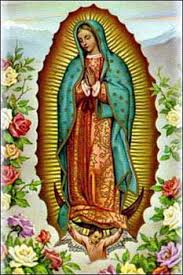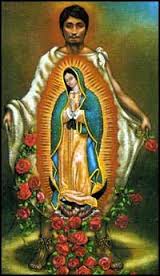 In the area of the New World of 1521 which is called Mesoamerica, the Spanish forces conquered the capital city of the Aztec empire. For at least five centuries the inhabitants practiced a polytheistic religion which featured human sacrifice of a most bloody order. Between 20,000 and 50,000 men, women, and children, mostly slaves or captured peoples were sacrificed each year.
In the area of the New World of 1521 which is called Mesoamerica, the Spanish forces conquered the capital city of the Aztec empire. For at least five centuries the inhabitants practiced a polytheistic religion which featured human sacrifice of a most bloody order. Between 20,000 and 50,000 men, women, and children, mostly slaves or captured peoples were sacrificed each year.
Often part of the ritual included eating the victims’ limbs. In 1487 one such morbid episode was held for the dedication of the newly constructed temple to Huitzilopochtli, the snake god, in Tenochtitlan, which is now known as Mexico City. During this one ceremony lasting four days and nights, the Aztec ruler (and demon worshiper) Tlacaellel presided over the sacrifice of more than 80,000 victims. The temple was lavishly decorated with many images of serpents and the brutal slayings were accompanied by the constant beating of giant drums made of snakeskin.
This horrible historical happenstance calls to mind the barbaric practice of the ancient Canaanites, who sacrificed their first born children to the god Molech. The infants were first slain and then cremated by being tossed into the belly (furnace) of the Molech image. In 1999 Pope John Paul II entrusted the cause of life to the loving protection of Our Lady of Guadalupe, and placed under her care the innocent lives of children, and he particularly meant children who are in danger of being aborted.
Within ten years of the fall of the Aztec capital, there was at least some conversion amongst the Indian populace to Christianity due to the diligence of the Spanish priests who arrived with the conquerors. However, just before dawn on a frosty Saturday morning early in the month of December in 1521 a “Lady of Heaven” appeared to a poor Indian convert, Juan Diego, who was on his way to conduct some errands in the city. Hearing singing resembling the singing of varied birds he climbed the hill known as Tepeyacac, a locale northwest of Mexico City. There the apparition took place. A beautiful lady identified herself as the Mother of the True God, and instructed him to have the bishop build a temple on the site.
The bishop (named Father Juan de Zumarraga – a Franciscan religious) received the Indian politely and listened attentively, but was not convinced that it was not just the poor man’s imagination. Juan Diego returned the next day, but the bishop still was not moved, but requested some sign that this indeed was a message from the Mother of Jesus.
 Subsequently, and at the direction of the Lady of Heaven, Juan Diego found exquisite rosas de Castilla blooming on the hilltop location of the apparition long before the time of budding, and even if they did bud, they would certainly freeze in the cold December season. The flowers were most fragrant and covered with dewdrops which resembled precious pearls. The hilltop was no place for any kind of flowers to grow as it was generally covered with thistles, thorns and the like. In December, all vegetation is subject to freezing in those parts. Juan cut some flowers, brought them to the Lady from Heaven, who saw them, took them with her hand and placed them in Juan’s tilma (a poor quality cactus-cloth) saying: “My son this diversity of roses is the proof and the sign which you will take to the bishop.”
Subsequently, and at the direction of the Lady of Heaven, Juan Diego found exquisite rosas de Castilla blooming on the hilltop location of the apparition long before the time of budding, and even if they did bud, they would certainly freeze in the cold December season. The flowers were most fragrant and covered with dewdrops which resembled precious pearls. The hilltop was no place for any kind of flowers to grow as it was generally covered with thistles, thorns and the like. In December, all vegetation is subject to freezing in those parts. Juan cut some flowers, brought them to the Lady from Heaven, who saw them, took them with her hand and placed them in Juan’s tilma (a poor quality cactus-cloth) saying: “My son this diversity of roses is the proof and the sign which you will take to the bishop.”
Juan had a difficult time getting past the bishop’s servants and officials to present his precious cargo, but when Zumarraga heard the commotion, he summoned Juan to come forward. Juan unfolded his cloth cloak where he sheltered the flowers, and when they fell to the floor, they were still beautiful and fresh, but more to the amazement of all present there was imprinted on the tilma the Image of the ever-virgin Holy Mary, Mother of God. When the bishop saw the image, he fell to his knees. The bishop begged forgiveness for not having granted the wish to build the temple.
Eventually the temple was built at Tepayacac, which is named Guadalupe. There to this day, one can find the image still as fresh as ever on the tilma. The coarse fabric of the tilma should have deteriorated within 20 years of its weaving; yet almost 500 years later it is still vibrant. For over a century the sacred image hung unprotected even by glass in a damp open-windowed chapel where it was exposed to ceaseless smoke and incense, burnt perfumes and candles flickering beneath it. On November 14, 1921, a powerful bomb placed beneath the sacred image exploded, ripping out chunks of marble from the sanctuary. Yet the image of Our Lady was completely unharmed. This defies all scientific explanations.
In 1936 Richard Kuhn, a German Nobel Prize winner in Chemistry examined fibers from the image. He found that the materials used to produce the colors were unknown to science, being neither animal, vegetable nor mineral dyes. In 1981 The Center for Applied Research in the Apostolate (CARA) published an analysis of the Tilma under Infra Red Radiation by Dr. Philip Serna Callahan, a biophysicist at the University of Florida. Dr. Callahan found that “the original figure…is inexplicable. In terms of this infrared study, there is no way to explain either the kind of color pigments utilized or the maintenance of color luminosity and brightness over the centuries. It is remarkable that after four centuries there is no fading or cracking of the original figure or any portion of the ayata tilma which – being unsized – should have deteriorated centuries ago.”
The tilma of Juan Diego has been observed by 17 generations of witnesses. It has been examined by experts who maintain that its continued existence is an exception to the physical laws of science and who cannot explain according to those same physical laws either how the image was painted or what materials were used to paint it.
But wait, there’s more. In 1929, Alfonso Marcue, who was the official photographer of the old Basilica of Guadalupe in Mexico City, found what seemed to be a clear image of a bearded man reflected in the right eye of the Virgin (Zumarraga?). After many inspections of many of his black and white photographs he had no doubts and decided to inform the authorities of the Basilica.
More than 20 years later, on May 29, 1951, Jose Carlos Salinas Chavez, examining a good photograph of the face, rediscovered the image of what clearly appears to be a bearded man reflected in the right eye of the Virgin, and locates it on the left eye too. Since then, many people had the opportunity to inspect closely the eyes of the Virgin on the tilma, including more than 20 physicians and ophthalmologists.
The first one, on March 27, 1956, was Dr. Javier Torroella Bueno, MDS, a prestigious ophthalmologist. In what is the first report on the eyes of the image issued by a physician, certified the presence of the triple reflection (Samson-Purkinje effect) characteristic of all live human eyes and stated that the resulting images are located exactly where they are supposed to be according to such effect, and also that the distortion of the images agreed with the curvature of the cornea.
The same year another ophthalmologist, Dr. Rafael Torrija Lavoignet, examined the eyes of the image with an ophthalmoscope in great detail. He observed the apparent human figure in the corneas of both eyes, with the location and distortion of a normal human eye and specially noted a unique appearance of the eyes: they look strangely “alive” when examined. Many other examinations by ophthalmologists have been done of the eyes of the image on the tilma after these first ones. With more or less details all have agreed with the conclusions of those mentioned.
In 1962, Dr. Charles Wahlig, O.D. announced the discovery of two images apparently reflected in the eyes of the Virgin having studied a photograph enlarged twenty five times. In 1979 Dr. Jose Aste-Tonsmann announced the finding of at least four human figures apparently reflected in both eyes of the Virgin. Dr. Tonsmann used sophisticated image processing techniques with digitized photographs of both eyes.
Dr. Aste-Tonsmann published his last studies on the eyes on the tilma in the book “El Secreto de sus Ojos”, with complete details and photographs of his work. Perhaps one of the most fascinating aspects of the studies was his conclusion that Our Lady of Guadalupe not only left us a miraculous image as proof of her apparition but also some important messages too. These messages were hidden in the eyes on the image until present times, when new technologies allow them to be discovered – when they seem most necessary.
This would be the case with the image of a family in the center of the Virgin’s eye. In these times, families are under serious attack in our modern world. The image of various human figures that seem to constitute a family (including various children and a baby carried on the woman’s back as common in the 16th century) appears in the center of the pupil.
An incredible list of miracles, cures and interventions are attributed to Our Lady of Guadalupe. Less than 20 years after the apparition there were some nine million conversions from Aztec paganism to Christianity. Yearly, an estimated 10 million visit her Basilica, making her Mexico City home the most popular Marian shrine in the world, and the most visited Catholic Church in the world next to the Vatican.
Altogether 24 popes have officially honored Our Lady of Guadalupe. His Holiness John Paul II visited her Sanctuary four times: on his first apostolic trip outside Rome as Pope in 1979, and again in 1990, 1999 and 2002.
The Feast of Our Lady of Guadalupe is celebrated on December 12th. In 1999, Pope John Paul II, in his homily from the Solemn Mass at the Basilica of Our Lady of Guadalupe, declared the date of December the 12th as a Liturgical Holy Day for the whole continent.
***Note: This beautiful story of Juan Diego and Our Lady was sent to me by a friend via the web. There was no attribution as to the author or the original source. If you know the original publication or author I will be glad to offer proper credit and links to the original work.***